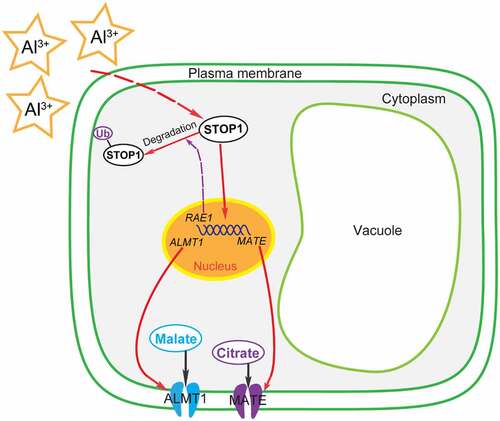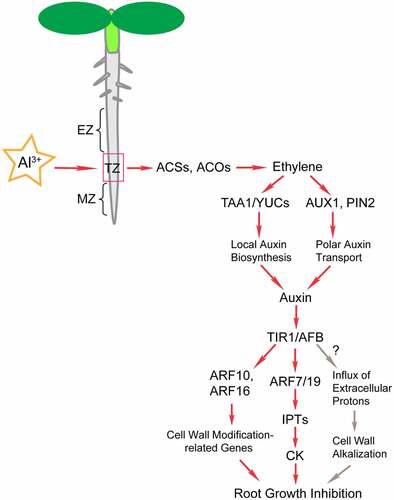Figures & data
Figure 1. Proposed model for the regulation of malate and citrate secretion by STOP1 in response to Al stress and the proposed signaling pathway of Al-activated root malate and citrate exudation based on recent research on Arabidopsis.Citation6,Citation18,Citation73,Citation94,Citation95 In response to Al stress, Al3+ signals can be perceived by the plant and trigger the accumulation of STOP1 in the cell. As a transcription factor, STOP1 upregulates the expression of RAE1, ALMT1, and MATE. RAE1 reduces the amount of STOP1 by promoting the ubiquitination (Ub) and degradation of STOP1.Citation6,Citation18,Citation95 Al-activated excretion of malate and citrate occurs through the PM localized transporters of ALMT1 and MATE, respectively. The secretion of OAs plays a critical role in plant Al tolerance through the chelation of external Al.

Table 1. Related genes responsible for Al-activated secretion of OAs and plant Al-resistance
Table 2. Hormone signaling-related genes in plant response to Al stress
Figure 2. Schematic representation of ethylene- and auxin-mediated regulation of root growth inhibition in response to Al stress. The proposed hormone signaling pathway under Al stress was based on recent research on plants.Citation8,Citation19,Citation20,Citation87,Citation108,Citation110,Citation111,Citation114,Citation115 The root tip is considered the main site that identifies Al toxicity. The transition zone (TZ) between the meristem and the elongation zone of the root apex is the most sensitive area for plants to perceive Al stress. Al stress induces auxin response in the root TZ, which is dependent on the ethylene signaling pathway. Al3+ was found to upregulate the expression of ACSs and ACOs and promote ethylene biosynthesis.Citation19 Ethylene promotes local auxin accumulation through TAA1- and YUCs-mediated local auxin biosynthesis.Citation8,Citation20,Citation110 In addition, ethylene promotes local auxin accumulation through AUX1- and PIN2-mediated polar auxin transport, resulting in root growth inhibition.Citation19,Citation108 ARF-mediated auxin signaling controls the Al-induced inhibition of root growth by regulating IPT-dependent cytokinin biosynthesis and cell wall modification-related genes.Citation8,Citation110,Citation111

